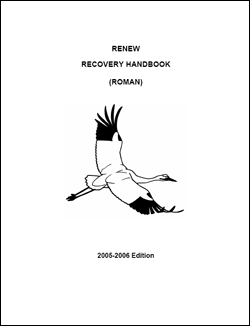Recovery Guidance Handbook (ROMAN)

National Recovery Working Group, Recovery Guidance Handbook (ROMAN), 2005, 93 pages.
Note
The guidance provided in this handbook represents the current best practices for recovery. The recovery processes and program are continually evolving, to meet new jurisdictional legislative and policy requirements, and to adapt to experience gained by field-testing procedures.
In 1996, a National Framework for the Conservation of Species at Risk was developed to provide a coordinated national approach for the conservation of species at risk. Federal, provincial and territorial ministers responsible for wildlife committed to this national approach in the corresponding Accord for the Protection of Species at Risk.
The Recovery Handbook (ROMAN) describes the policies and operations of the national recovery program known as RENEW (acronym for REcovery of Nationally Endangered Wildlife). The handbook has been prepared, and will continue to be developed and maintained as a dynamic document, by the National Recovery Working Group (NRWG). RENEW was initiated in 1988 and evolved to become the recovery implementation component of the National Framework for the Conservation of Species at Risk.
The handbook provides the conceptual and operational basis for the national recovery program. Its audience is primarily national recovery teams and recovery staff of the jurisdictions that are accountable for species recovery in Canada. Other organizations and individuals participating in, or interested in, the recovery of species at risk will also find it a useful resource.
The purpose of this handbook is to:
- Provide an overview of the roles and responsibilities, processes and products pertaining to the recovery of nationally endangered, threatened or extirpated species.
- Describe flexible guidelines for use by recovery practitioners such as recovery teams that can be adapted to fit specific situations.
For a glossary of terms and acronyms, refer to Appendix A.
The task of recovering species is challenging, due to the complexity of the factors (biological, legislative, socio-economic) involved. This handbook represents a general, multi-jurisdictional basis for recovery efforts; however, it will be necessary to adapt the processes described here to unique situations as they arise. Some alternatives to recovery planning structures and approaches are presented in the handbook. The search for cost-effective and biologically promising tools for species recovery continues to engender much discussion across the country.
Additional background materials and other documents relating to species recovery have been added as annexes to the handbook. The provincial and territorial government wildlife agencies are working with the three federal agencies responsible for SARA (the federal Species at Risk Act), to harmonize the requirements for recovery arising from federal, provincial and territorial endangered species legislation and policies. The guidance in this document represents the integrated national recovery process to the extent that it has been worked out to date.